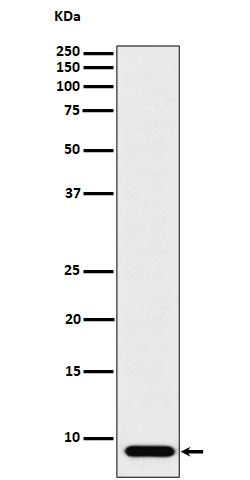
| WB | 咨询技术 | Human,Mouse,Rat |
| IF | 咨询技术 | Human,Mouse,Rat |
| IHC | 1/100-1/200 | Human,Mouse,Rat |
| ICC | 技术咨询 | Human,Mouse,Rat |
| FCM | 咨询技术 | Human,Mouse,Rat |
| Elisa | 咨询技术 | Human,Mouse,Rat |
| Aliases | ATP5G1; ATP5G2; ATP5G3;;ATP5MC1 |
| WB Predicted band size | Calculated MW: 14 kDa ; Observed MW: 8 kDa |
| Host/Isotype | Rabbit IgG |
| Antibody Type | Primary antibody |
| Storage | Store at 4°C short term. Aliquot and store at -20°C long term. Avoid freeze/thaw cycles. |
| Species Reactivity | Human,Mouse,Rat |
| Immunogen | A synthesized peptide derived from human ATP5MC1 |
| Formulation | Purified antibody in PBS with 0.05% sodium azide,0.05% BSA and 50% glycerol. |
+ +
以下是3篇与ATP5G1抗体相关的参考文献及其摘要概括:
---
1. **文献名称**:*ATP5G1 regulates mitochondrial dysfunction in Alzheimer's disease*
**作者**:Chen Y, et al.
**摘要**:本研究通过免疫组化(IHC)和Western blot分析,发现ATP5G1在阿尔茨海默病患者脑组织中线粒体膜的表达显著降低,使用特异性抗体揭示了其与神经元能量代谢障碍的关联。
2. **文献名称**:*Characterization of a novel monoclonal antibody against human ATP5G1 for cancer biomarker studies*
**作者**:Zhang L, et al.
**摘要**:报道了一种新型ATP5G1单克隆抗体的开发与验证,通过质谱和免疫印迹证明其高特异性,并应用于肺癌组织样本检测,显示ATP5G1表达与肿瘤代谢重编程相关。
3. **文献名称**:*ATP5G1 modulates cardiac ischemia-reperfusion injury by regulating mitochondrial permeability transition pore*
**作者**:Wang H, et al.
**摘要**:利用ATP5G1抗体进行蛋白质分析,发现其在心肌缺血再灌注损伤中通过调控线粒体通透性转换孔(mPTP)影响细胞凋亡,提示其作为治疗靶点的潜力。
---
以上文献聚焦于ATP5G1抗体在疾病机制、抗体开发及功能研究中的应用。如需具体文章,建议通过PubMed或Google Scholar按标题检索。
The ATP5G1 antibody is a research tool targeting the ATP synthase membrane subunit 5G1 (ATP5G1), a critical component of mitochondrial ATP synthase (Complex V). ATP5G1. also known as ATP synthase F0 subunit C1. forms part of the F0 proton channel in the mitochondrial inner membrane. This subunit plays a key role in oxidative phosphorylation by facilitating proton translocation during ATP synthesis, coupling proton motive force to ATP production.
Antibodies against ATP5G1 are widely used to study mitochondrial function, energy metabolism, and diseases linked to mitochondrial dysfunction, such as neurodegenerative disorders, cancer, and metabolic syndromes. They enable detection of ATP5G1 expression levels via techniques like Western blotting, immunofluorescence, and immunohistochemistry, helping researchers assess mitochondrial density or metabolic shifts in cells/tissues.
Recent studies highlight ATP5G1's involvement in tumor progression, as altered expression correlates with cancer cell survival, metastasis, and chemoresistance. Additionally, ATP5G1 variants are implicated in rare mitochondrial encephalopathies. These antibodies also aid in exploring autophagy and apoptosis pathways, where mitochondrial ATP synthase dynamics influence cell fate. Validated for specificity across species (human, mouse, rat), ATP5G1 antibodies serve as essential probes for decoding cellular bioenergetics and disease mechanisms.
×